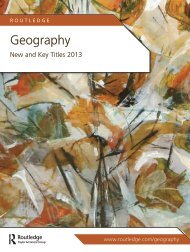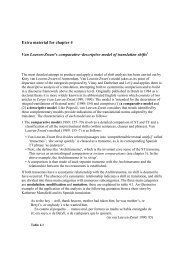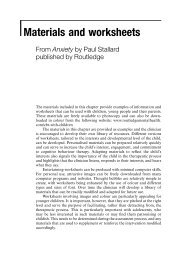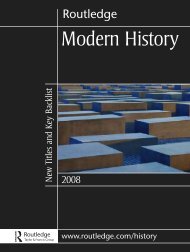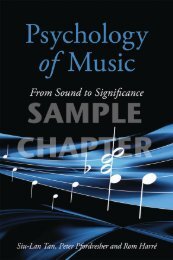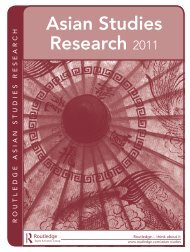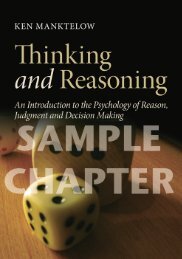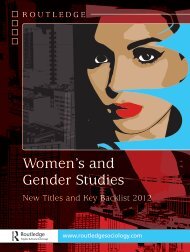Sport and Exercise Psychology: A Critical introduction ... - Routledge
Sport and Exercise Psychology: A Critical introduction ... - Routledge
Sport and Exercise Psychology: A Critical introduction ... - Routledge
You also want an ePaper? Increase the reach of your titles
YUMPU automatically turns print PDFs into web optimized ePapers that Google loves.
USING IMAGINATION IN SPORT<br />
measure of “visual imagery of movement itself <strong>and</strong> imagery of kinaesthetic sensations”<br />
(Isaac et al., 1986, p. 24). Each of the items presents a different movement or<br />
action to be imagined (e.g., riding a bicycle). Respondents are required to rate these<br />
items in two ways: “watching somebody else” <strong>and</strong> “doing it yourself”. The ratings<br />
are given on a five-point scale where 1 = “perfectly clear <strong>and</strong> as vivid as normal<br />
vision” <strong>and</strong> 5 = “no image at all”. Although not extensive, available evidence<br />
suggests that the VMIQ satisfies conventional st<strong>and</strong>ards of psychometric adequacy.<br />
Eton et al. (1998) reported that it had high internal consistency coefficients (e.g., 0.97<br />
for the total scale) <strong>and</strong> a test-retest reliability score of 0.64 (for the “other” subscale)<br />
to 0.80 (for the “self” score) over a two-week interval. Lequerica et al. (2002) reported<br />
a high internal consistency value of 0.95 for the visual imagery subscale <strong>and</strong> 0.97 for<br />
the kinaesthetic imagery subscale. An amended version of this test called the<br />
Vividness of Movement Imagery Questionnaire-2 (VMIQ-2) was published by<br />
R. Roberts et al. (2008) (see Box 5.6).<br />
Box 5.6 A new test of movement imagery in athletes: revising the Vividness<br />
of Movement Imagery Questionnaire<br />
Although the Vividness of Movement Imagery Questionnaire (VMIQ: Isaac<br />
et al., 1986) has been one of the most popular <strong>and</strong> psychometrically sound<br />
imagery tests used in sport psychology, it has several limitations that were<br />
identified by R. Roberts et al. (2008). First, the VMIQ appears to confound two<br />
different imagery modalities – visual <strong>and</strong> kinaesthetic. Thus it requires respondents<br />
to imagine performing movements themselves but does not instruct them<br />
to use the kinaesthetic modality rather than the visual one, even though first<br />
person visual imagery (IVI) <strong>and</strong> kinaesthetic imagery are regarded as separate<br />
modalities (Fourkas et al., 2006b). Second, as the visual imagery subscale of the<br />
VMIQ requests respondents to imagine someone else performing actions (as<br />
distinct from watching oneself performing these actions), it fails to measure<br />
adequately external self-imagery. Third, the VMIQ has not been subjected to<br />
confirmatory factor analysis – a technique commonly used to investigate the<br />
construct validity of a psychometric test. To address these problems, R. Roberts<br />
et al. (2008) developed the Vividness of Movement Imagery Questionnaire – 2<br />
(VMIQ-2). This test consists of twelve items <strong>and</strong> assesses the ability to form<br />
mental images of a variety of movements visually <strong>and</strong> kinaesthetically. The<br />
visual component is further subdivided into “external” <strong>and</strong> “internal” visual<br />
imagery. Respondents are required to imagine each of the twelve movements<br />
<strong>and</strong> to rate the vividness of each item on a Likert-type scale from 1 (“perfectly<br />
clear <strong>and</strong> vivid”) to 5 (“no image at all”). The VMIQ-2 displays impressive<br />
factorial validity <strong>and</strong> acceptable concurrent <strong>and</strong> discriminate validity.<br />
Turning to the MIQ-R (C. Hall <strong>and</strong> Martin, 1997), this test is especially<br />
interesting for sport researchers because it was designed to assess individual<br />
differences in kinaesthetic as well as visual imagery of movement. Briefly, this test<br />
contains eight items which assess people’s ease of imaging specific movements<br />
http://www.psypress.com/sport-<strong>and</strong>-exercise-psychology-9780415434317<br />
191



